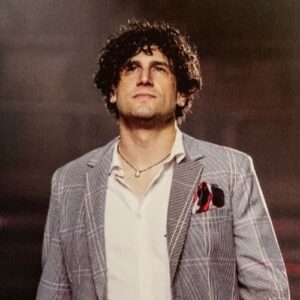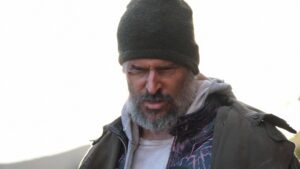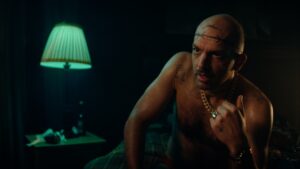
With just three feature films (and a couple of shorts and an anthology segment), filmmaker Adam Egypt Mortimer has established himself as quite a master of genre filmmaking. His 2019 horror film Daniel Isn’t Real was particularly well-crafted and received, and he follows that with Archenemy, a crime-thriller-esque take on superheroes with Joe Manganiello playing Max Fist, a homeless drunk who claims that he’s actually a hero from another dimension. Two teens named Hamster and Indigo (Skylan Brooks, Zolee Griggs) believe Max’s stories and think he can help them take down the local gangsters, led by Glenn Howerton’s “The Manager,” who have been flooding their community with drugs.
Like Daniel Isn’t Real, it’s a super-stylish movie that uses departments like Production Design and music to really set Archenemy apart from other genre films, but also includes some animated sections depicting Max Fist as a superhero in this other world.
Below the Line spoke with Mortimer over the phone for the following interview, in which we discussed things like maintaining Daniel’s stylish look and feel into Archenemy while working with an all-new team.

Below the Line: I think Daniel Isn’t Real came out last year, so that’s a pretty fast turnaround for another movie.
Andrew Egypt Mortimer: Yeah, man. I was doing a Q&A at the Alamo Drafthouse Downtown on a Sunday night, and then woke up at 5am the next day to start shooting Archenemy, that’s how back-to-back it was, which was crazy, but just like the most wonderful thing. There was a minute when we were working on Archenemy, and I was like, “I don’t think we have enough money, I don’t think we have enough time. This is crazy, I need a break.” I have been waiting my entire life for somebody to give me money for a movie I want to make. I can’t say “No” just because it’s hectic. It was wonderful, and it was such good timing that we were done shooting right before the pandemic so in all the lockdown time, I was in post and getting the movie ready. That was also a real lucky situation.
BTL: Did you shoot all of this in L.A.?
Mortimer: Yeah, it was all in L.A., a lot of downtown L.A., a little bit of Castaic and some locations in Van Nuys, but it was all local, which was interesting. For Daniel Isn’t Real, I was in New York, so I was living in New York for months working on that movie, which is also very cool. Sometimes, I worry about if you do it locally, is there really like enough focus? Can you live your regular life, and that pulls you away from a movie? The reality is working on the movie 18-19 hours a day and collapsing in your own bed and then getting up and going. It was sort of fun to be shooting around LA, like we did stuff in Echo Park, which was a neighborhood that I used to live in, shooting some scenes, and a bar that I used to hang out in. Things like that are just sort of fun and having a sense of the texture of the city and knowing what little alleyways we might want to peer into was helpful.
BTL: So you can give us the definitive answer to which is better, shooting in L.A. or shooting in New York?
Mortimer: From a budget-conscious perspective, I found New York incredibly difficult. For the low budget that we had on Daniel Isn’t Real, the restrictions that we had with unions and things like that were very, very difficult, extraordinarily difficult for when you’re trying to make a movie and you’re more used to run and gun guerrilla approach. It was much easier from that perspective in Los Angeles. The other thing that made L.A. nice is this is a movie that has this wild cast of colorful characters, and I was able to get Paul Scheer to come in for a day and shoot his totally insane scene. I was able to get Glenn Howerton to show up for a couple days. I was able to get Amy Seimetz. All of these people would have been harder, especially on our budget. We don’t have any budget for travel or anything like that, so to be able to have people wake up from their homes and drive to the set, made our cast so much juicier.
BTL: I didn’t even recognize Sheer at first, although he sounded familiar.
Mortimer: I had somebody come to the set that day, a friend of mine, and end of the day, he was like, “I just realized that’s Paul Scheer.”
BTL: What was the original idea, because you said you’d been wanting to make this for a while. Was this originally an idea for a comic that developed into this?
Mortimer: I’ve always loved comic books, and I’ve never stopped reading comic books since I was a kid. I’ve felt like they treat the stories around superheroes in such a sophisticated way. There’s so many different kinds of genres and different kinds of aesthetic experimentation that comics do. Whereas in movies, it’s like superheroes are a genre. I wanted to try to make a superhero movie that treated the movie going audience in the same way, as the same kind of sophisticated superhero aficionados, the comic books, treat their readers. It’s a very sophisticated audience reading comic books, who really understand what a superhero is. I knew I didn’t have to f*ck around with origin stories and things like that. We can just jump right into a really deconstructed cosmic crazy take and create a completely different aesthetic. That was something that I wanted to do, you know, very broadly speaking. I wanted to make a superhero movie that’s kind of like Aronofsky’s the wrestler, take this character after the end of his career, and he’s broken, and he’s looking back on the past. What really happened to lead him here? That was all sort of the initial inspiration years ago, when I started thinking about the movie.

BTL: You ended up creating some animation and comics artwork to tell Max’s story. Did you already have friends or people you knew who did that sort of stuff or did you have to look around for the right animator?
Mortimer: I looked around quite a lot, at a lot of different kinds of artists, and had a lot of different conversations with people and then wound up working with a designer, comic book artist named Sunando C, who I had worked with before, a few years ago on a comic book that we have been slowly developing together. There’s a funny thing that seems to always happen is you look everywhere, and then you wind up going back, and like, “Oh, yeah, this guy was here all along.” It was a really small team. It was him drawing pictures, it was a guy named Danny Perez, who’s a filmmaker himself, creating all of these great psychedelic animations and then one more person, Kevin [Finnegan], who ran all of the animation and figured out how to do everything in 2D and 3D and 2 1/2D, so it was just this super-small, contained group that were just working together to sort of experiment and create these strange visual pieces.
BTL: Even though you finished shooting before the pandemic, you probably did a lot of post during lockdown. From your experience, how were you able to collaborate and work with your post team remotely?
Mortimer: My editor, Lana Wolverton, and I worked remotely the entire way. We used Zoom, and she would share her Avid screen, and we edited the whole movie that way. We still haven’t been in the same room together, ever, but we cut the whole movie. That process was actually really smooth. I don’t think there was anything about it that was inferior to going to an edit bay. My producer would jump onto the Zoom, and all three of us would be working together. It was actually probably better than having to drive to some edit bay in Santa Monica. I could just chill out, and I had the editor on my iPad, sometimes I put it on my TV screen. It was awesome, especially when so many people I know had their jobs fall apart or something they were halfway through shooting got shut down. We were just in post. It got a little bit more complicated when we got into color grade and the sound mix. We were sending files back and forth and figuring out how to stream. Eventually, there was a safe protocol for going into sessions a little bit. For the most part, it was a pretty seamless post process in the remote world, and I was really happy to be able to work that way.
BTL: I really liked the look and feel of Daniel’s, and I liked the look and feel of this one, too, but you went with a different cinematographer, different composer, different editor – how did you find these people and why switch between movies?
Mortimer: I think it’s interesting that it was such a different group of people, but hopefully, the movie still shares a similar vision. I think you always start off with saying, “Well, I’m gonna work with all the same people. Lyle Vincent, who shot Daniel Isn’t Real was in Thailand shooting a movie, and Clark the composer, he wasn’t available. None of the people — my production designer within England or Amsterdam. Nobody could do it, and we didn’t have any money to bring anybody here, so I just found new people. I find that the process of hiring department heads… I can really learn a lot about the movie that way. It’s a lot like casting. I told my producer, I was like, “Set me as many meetings as possible with production designers. I want to talk, talk to everybody. I want to have an opportunity to articulate exactly what I’m going for.” You really wind up just looking for people that I can kind of just jam with, people who I’ll have like a cool, emotional connection with. You’re always going to get everybody’s portfolios and resumes [and they] are all really good. You’re looking at good people, but how do you decide who’s going to fit in? You start telling stories about yourself and seeing what clicks. Seeing why they are excited to do the movie, how are they relating it to their personal life? That’s what I did for all of these people, and I think it worked out. It was a really good group of people who really had to deal with a lot. [laughs]
BTL: By the way, I didn’t mean my earlier comment to be negative. I was just amazed that you got a movie just as stylish, but using completely different people to get there.
Mortimer: I know. It’s crazy, right? That’s a crazy thing to do. The last movie turned out really well and people liked it, so now I’m going to hire entirely different people. It wasn’t really a choice, but once it became a necessity, I sort of leaned into, “Great! Now I’ll make a lot of new friends.” I think it’ll be fascinating for me to see… I try to be very stylistically specific, and I’m curious to see if people will say, “Oh, these feel like the same kind of movie” or if they’ll be like, “Oh, there’s something really wrong.” I’ll be curious to see that.

BTL: I really liked how the characters looked, and I wondered about working with your production designer, costumes, hair and makeup on that. Even Joe Manganiello looks quite disheveled, and I didn’t even recognize Glenn or Paul. They all look very different.
Mortimer: Yeah, those departments — the wardrobe, the makeup, and the hair were so crucial in this movie. Michelle Laine was the wardrobe designer, and she brought such a great sense of color and specificity and like weird patterns. She would not let a single character in the movie, just be like, “Oh, he’s a goon, put them in a hoodie or whatever.” Every single character has a whole life, and people would show up to play a character for just like one or two days and be like, “Oh my God, I’ve never had a wardrobe like this before. It’s so cool.” One of the hired goon guys, he has this amazing wolf-print windbreaker and he was like, “I’m taking this. Can I take this?“ Similarly with the makeup, Mazena Puksto, who did the makeup, I would be like, “I want face tattoos” and she found this wonderful way of making some of the characters so grimy, and breaking out Joe’s teeth, and everybody has scars and grime and cool f*cking neck tattoos. When it comes to Amy Seimetz or Zolee Griggs, she makes them sort of otherworldly and beautiful and amazing, but also very believable. Same with Terry, the hair designer – it was just this great unit of people really thinking about, “Who are these people? And how do we make them seem real, but also give the whole thing this sense of color and energy?” My whole ethic on something like this is that I want the world to feel really bleak and violent and gnarly, but the characters within it are colorful and struggling to have energy and be hopeful. I think those departments really found that. It’s a treat to take Joe and give him like the gnarliest coats that are ripped-up and shredded, he’s been living under a bridge. I love that a single wardrobe designer can go from looking at the highest fashion and streetwear trends and then just dress Joe to look like total garbage and still have it look kind of cool and have sort of a samurai feel.
BTL: My last question for you is about the music. Again, I liked the music in Daniel Isn’t Real, but I really liked the music in this one. What was the direction you gave to the composer in terms of what you were looking for? Did you have any references?
Mortimer: I was trying to figure out a way to be cosmic, but also sort of tragic and emotional. Matt Hill is the composer, and he’s put out all these records as “Umberto,” and they’re really great records – he’s also a musician. I would talk to him about krautrock like 70s cosmic German rock music. But then we’d also talk about, “How do you create the sense that Max is lost? How do you create the tragedy, but keep everything moving, like the energy? I think there’s like non-stop music, and I would feel sometimes he would go too dreamy and then it would start to feel depressing. I was like, “They can be doing depressing things, but it should feel like there’s this propulsive motion to it.” SpectreVision, my producers, are really good with music, so Daniel Noah at SpectreVision would work very closely with Matt also. He really understands where music in a scene should go and how sequences should work, so we worked really well together with the composer to do all of that stuff.
Archenemy will hit theaters and On Demand on Friday, December 11.
All photos courtesy of RLJEfilms.





